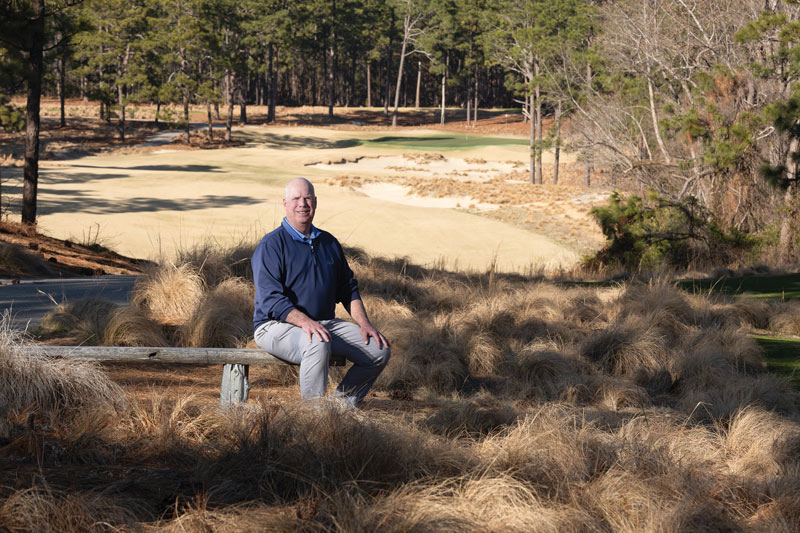
David Fruchte, CGCS. Photo by Tim Sayer
David Fruchte, CGCS, was in a hurry. For that matter, so was his wife, Ann.
In March 1990, the Fruchtes packed up their belongings in Tennessee to make the drive to North Carolina. They undertook the journey in separate cars so they could haul plenty of stuff. David had been hired as superintendent at Pine Needles Lodge &
Golf Club in Southern Pines, N.C., where a new challenge awaited. The process had to wait a little bit longer than they anticipated, however. Both got pulled over and issued speeding tickets — at the same time — along the route.
“I guess he was in a hurry to get to work,” says Kelly Miller, who has been at Pine Needles for 40 years and is its president. “Fortunately, he’s not been in a hurry to leave.”
In June, Fruchte’s sturdy presence and a desire to establish residence for more than three decades in the Sandhills of North Carolina will make history for superintendents. When the 77th annual U.S. Women’s Open, presented by ProMedica, at
Pine Needles begins June 2, it will be the first time a superintendent has overseen four U.S. Women’s Opens. The first course to host three U.S. Women’s Open championships at the same venue was Atlantic City Country Club in Northfield,
N.J. (1948, 1965 and 1975).
Fruchte — director of grounds for three Donald Ross-designed courses (Mid Pines Inn & Golf Club and Southern Pines Golf Club are the others besides Pine Needles) — doesn’t pat himself on the back for being one of a kind. He wants
it to be known that others have done their part to help him make this achievement possible. “The family (owners) has given us what we need. I’m just fortunate to be a part of it,” Fruchte says.
A big part of it, if you ask Brad Rajner, who worked for nearly 14 years with Fruchte beginning in 2006. “To do what he’s done is incredible, and he’s done it at a course that has changed pretty much every time he’s hosted one,”
says Rajner, a 15-year GCSAA member who is superintendent at Oak Pointe Country Club in Brighton, Mich. “He does it right. He wants to see results. He wants his team to succeed.”
The making of an Open mainstay
What happened at Pine Needles early in Frutche’s career there was extremely rare.
Except for the Masters taking place annually in the same spot each year since 1934 at Augusta National Golf Club in Augusta, Ga., other major championships typically don’t return to a site for at least five years. Look no further than this year
for examples. The men’s U.S. Open at The Country Club in Brookline, Mass., is returning in June for the first time since 1988. Next month, Southern Hills Country Club in Tulsa, Okla., hosts its first non-senior major (the PGA Championship) since
2007.
Pine Needles, meanwhile, is an outlier — it staged three majors in 12 years (1996, 2001 and 2007). Miller says the wheels were set in motion just one year into Fruchte’s reign at Pine Needles during the 1991 U.S. Senior Women’s Amateur
there. Miller — whose mother-in-law is the late Peggy Kirk Bell, a legendary figure who is an LPGA co-founder and who along with her husband, Warren, bought and restored Pine Needles in the mid-1950s — was having a discussion with another
women’s golf icon, Judy Bell (no relation) during that amateur. Peggy Kirk Bell noted to Judy Bell how Pine Needles had the younger women in 1989 for the U.S. Girls’ Junior and the seniors in that 1991 championship, but something was missing.
“Peggy said to Judy, ‘When are we going to get some pros?’ Judy looked at me and said, ‘You sure you want it?’ Then she said to Peggy, ‘You want it? You got it.’ We signed up for it,” says Miller. “We
got kind of used to it. It (three non-Masters majors in barely more than a decade at one venue) is pretty unprecedented.”
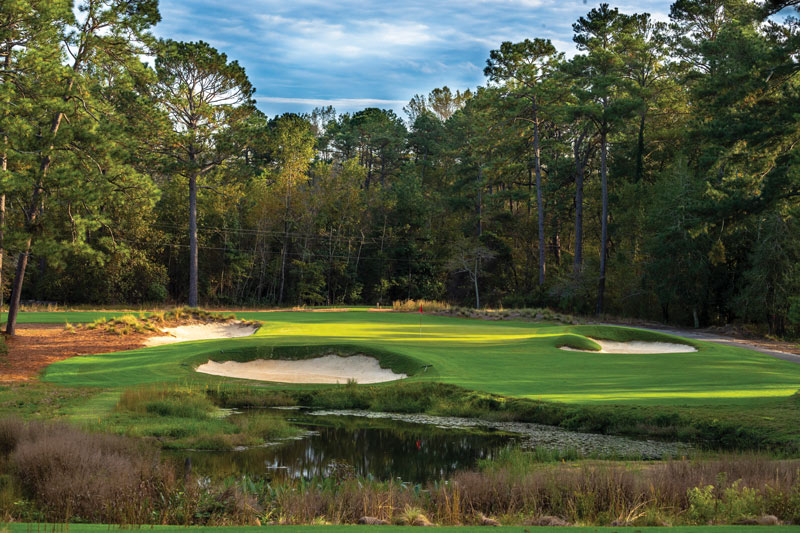
The familiar look of a Donald Ross design is on full display at Pine Needles Lodge & Golf Club in Southern Pines, N.C., which hosts the U.S. Women’s Open in June. Photo courtesy of the USGA
In 1996, the year of the U.S. Women’s Open’s Pine Needles debut, Judy Bell was elected the 54th president of the USGA, becoming the first woman to hold the office. Annika Sorenstam won that ’96 championship. This June, Sorenstam, GCSAA’s
Old Tom Morris Award recipient in 2014, will be back to play for a share of what is a women’s golf record-purse of $10 million.
Ask Fruchte what he remembers about all three of the championships, and weather stands out. “It was easy in 1996. Perfect weather. No rain,” he says. “In 2001, we had 2.5 inches of rain in 30 minutes on Friday (the maintenance crew from
Pinehurst Resort made the short drive to Pine Needles to supplement Fruchte’s crew). In 2007, we had rain each day, basically. We had to go to 7 a.m. shotguns, but we finished the tournament on time. Don’t ask me how we did it, but we
did.”
The outcome is what Chris Hobbs expected. Now the GCSAA Class A superintendent at Highland Country Club in Fayetteville, N.C., Hobbs spent nearly 10 years working for Fruchte and was superintendent at Pine Needles for the 2007 U.S. Women’s Open.
“He’s done it with bermudagrass greens, bentgrass greens, ryegrass, overseeded fairways. He has a dedication, commitment, to get the job done. He has a whatever-it-takes mindset,” says Hobbs, a 21-year GCSAA member. “For him
to be first to host four Women’s Opens ... I admire it. It’s impressive to be first at really anything.”
Restoring a legacy
Pine Needles looked into its past to secure its future.
Numerous changes and enhancements have recaptured a pre-World War II look from how Ross presented the course, which opened for play in the late 1920s. Most of the work to restore a throwback feel was finished five years ago. Fruchte and golf course architect,
consultant, builder and project manager Kyle Franz of KMF Design in Southern Pines (he also restored the Mid Pines course in 2013) addressed a bevy of aspects to help restore facets of the original design.
Greens were transformed to MiniVerde bermudagrass from bentgrass. The approximately 70 rolled-over style bunkers, introduced 80 years ago, underwent significant changes. “They already were flat-bottomed,” Fruchte says, “and now you can
see them a little bit more. Kyle edged them up partial way, so now you can see native areas coming down the slopes.” Eight new bunkers were added, partly in response to strategy and to increase challenges for today’s longer hitters. At
the par-5 first hole, a new bunker is located left of the second landing area, which brings its location more in play. And on the par-4 18th, a sandscape with vegetation along the left side of the downhill hole creates a test that wasn’t there
in 2007.
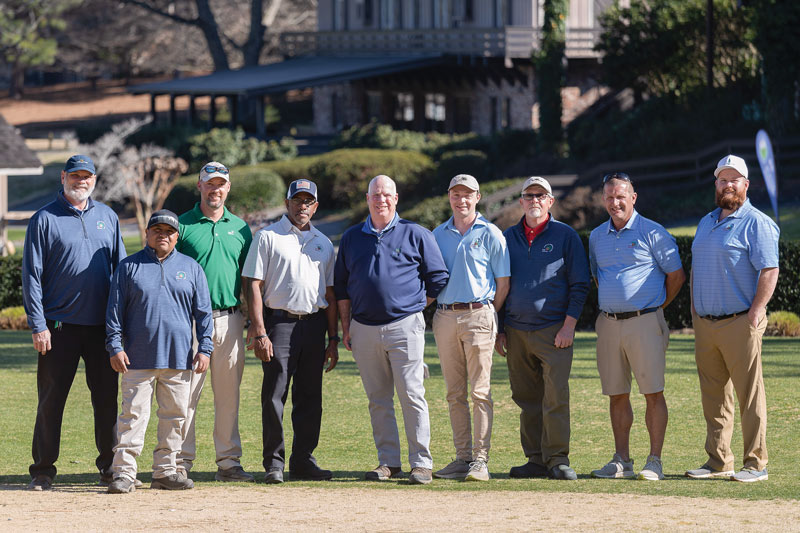
The grounds crew and equipment managers at Pine Needles, from left: Scott Nuzum, Juan Santos, Chris Mintmier, Raymond Smith, David Fruchte, CGCS, Tom Stier, Christopher Montague, Robert Schillawski and Cody Self. Photo by Tim Sayer
Eleven acres of bermudagrass rough were eliminated and replaced with wire grass and pine straw. That helped tighten up fairway landing areas and disposed of bermudagrass along the edge of the tree line, which provided a more native appearance. Sandscapes
were added around edges of fairways, which were expanded closer to their original width, ranging from 40 to 60 yards. Also, hundreds of trees were removed.
All of that work was completed in time for Pine Needles to host the U.S. Senior Women’s Open in 2019. Since that time, Fruchte says the course has been tweaked here and there in time for the U.S. Women’s Open in June, changes requested by
the USGA. About half the holes’ fairways were tightened. On No. 10, native wire grass in a sandy area cross feature was added in the landing area that will make players attempt to go over or stay short of it.
All of the work that has been accomplished at Pine Needles made Fruchte the perfect fit there, his former boss says. Fruchte worked under legendary superintendent David Stone at The Honors Course in Ooltewah, Tenn. While there, Fruchte got to interact
on occasion with golf architect icon Pete Dye, who took a shine to Fruchte, a Purdue University graduate and an Indiana native like Dye. “Probably of all the assistants I had, he (Fruchte) had more creativity as far as architecture,” says
Stone, a 49-year GCSAA member who retired at the end of 2016. “David was very good. A good golfer. Here, he put in some little short game greens with character in them to test varieties of grasses and put them in playing conditions. For him
to be there (Pine Needles) that long ... to do that, you have to present a very good product. You don’t last that long in one place if you don’t produce a good product.”
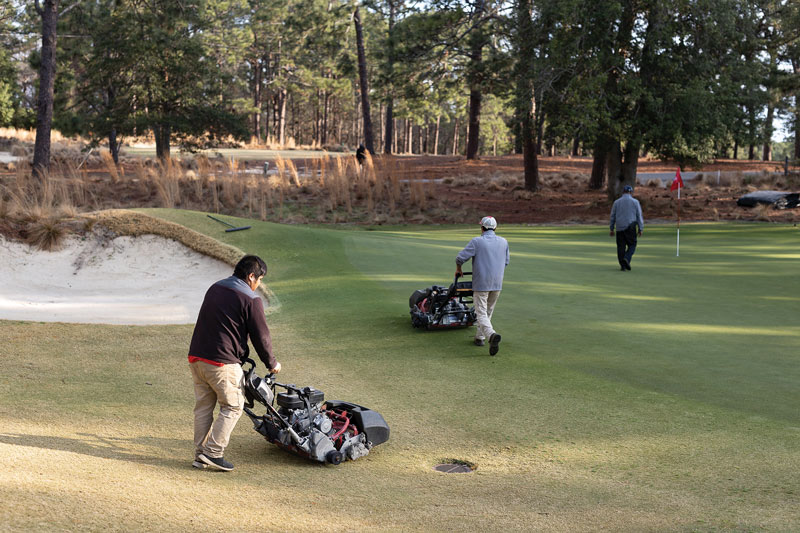
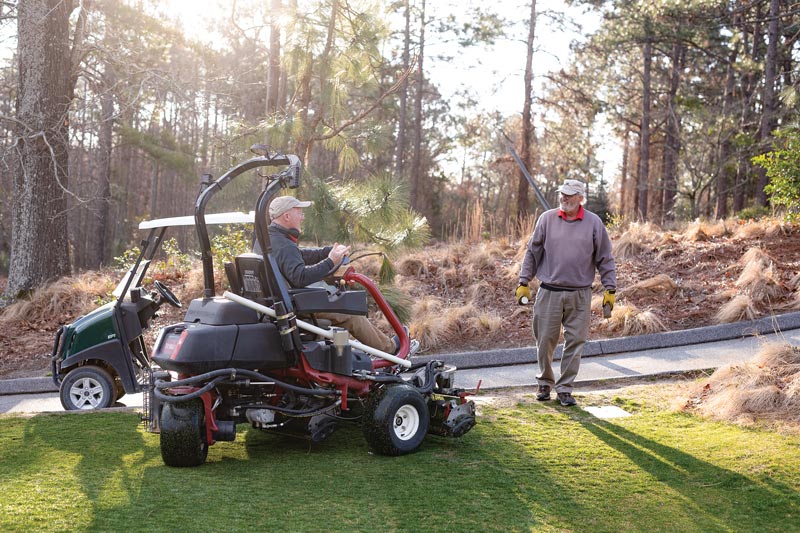
Top: Crew members (from left) Christian Martinez, Amos Flores and Raymond Smith. Bottom: Crew members Joe Little and Kenneth O’Neal. Photos by Tim Sayer
The product at Pine Needles now is dramatically different than when Fruchte hosted his third U.S. Women’s Open. “We had 25 to 30 acres of fairways, and now have 65 acres of short grass where we mow two or three times a week. Going from 30
to 65 is a lot,” says Fruchte, a 37-year GCSAA member whose biggest lesson learned hosting majors is to delegate more duties to his assistants. “In ’07, the rough was 2.5 (inches). Now it’s native areas. With Kyle’s group’s
help, we put in 50,000 wire grass plants, starting last September, and we finished up in March.
“Really, it’s a totally different golf course now than it was in 2007.”
The bottom line for Darin Bevard, director of championship agronomy for the USGA Green Section, is having a seasoned veteran such as Fruchte in charge at a course he knows like a relative. In 2021, Golf Digest ranked Pine Needles No. 73 on its America’s
100 Greatest Public Courses top 100. “The experience is what it comes down to. He knows the golf course; he knows the grass. That makes our lives a lot easier,” Bevard says. “People listen to what he has to say.”
No place like home
After that rather interesting arrival way back when, the Fruchtes truly settled in at Pine Needles.
They reside in a house off the 15th fairway. Occasionally, a wayward shot travels into their backyard, through a row of trees. Their children — son Jordan, who helped out on the crew in 2007, and daughter Megan — have grown up and left the
nest.
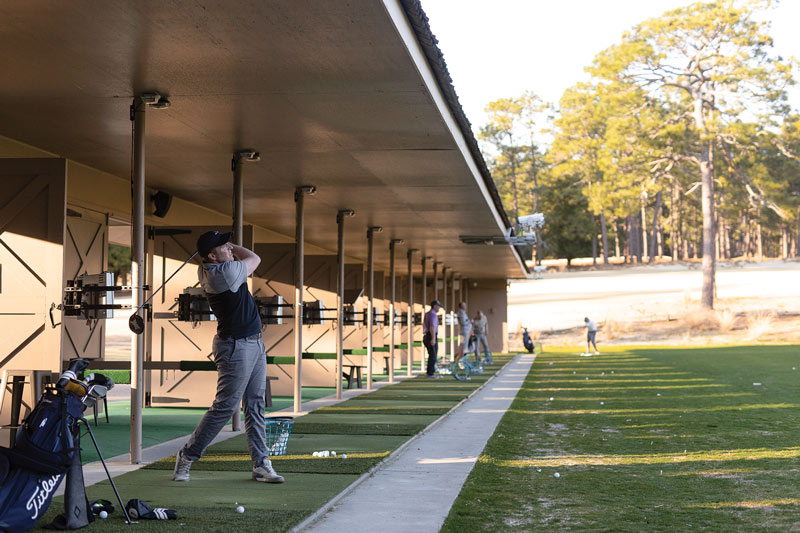
The covered driving range and putting
green area at Pine Needles. Photo by Tim Sayer
For Ann, one memory that stands out among all of those U.S. Women’s Opens is the first one 26 years ago. Before that, David won Ann over when she worked at the golf course her aunt and uncle operated in Decatur, Ind. During the week of the 1996
U.S. Women’s Open, he won her over all over again.
“We got in the golf cart, drove to a nearby pond where nobody was around, and (he) handed me a big, beautiful white magnolia flower. He did that in the midst of all that was going on,” Ann says. “Sweet and special.”
She also knows how special that golf course is to him. “He’s hard on himself, always wants to make it better. That’s the way he is,” Ann says.
He didn’t know when he made that memorable drive to North Carolina in 1990 that his journey would lead to a bushel of major championships, but Fruchte, 61, says he’s open to the idea of hosting another. Do we hear a fifth U.S. Women’s
Open? “We had three of them pretty fast. Now we’ll have a fourth. Who knows if another superintendent might do something like that again,” Fruchte says. “It is cool. And it keeps us on the map.”
Encore, women’s style
For the second straight year, a large squad of women volunteers from the industry will be on maintenance duty for the U.S. Women’s Open. This year, it is happening at Pine Needles Lodge & Golf Club in Southern Pines, N.C. Women have volunteered
at majors before, but not in the quantity that showed up for the 2021 U.S. Women’s Open at The Olympic Club in San Francisco. The same goes for this year at Pine Needles, and 30 of them will be on site for the entire week, from May 29 to June
5.
Pine Needles’ David Fruchte, CGCS, couldn’t be happier.
“We will have them here all week, which is going to be big for us,” Fruchte says. “We usually have some volunteers locally who are coming and going, to and from their own jobs at their courses, and we will have some of them again (not
to mention his own staff, including Pine Needles superintendent Chris Mintmier, Mid Pines superintendent Scott Nuzum and Southern Pines superintendent Cody Self), but to have the women here for the entirety will make things less stressful for all
of us.”
Syngenta territory manager Kimberly Gard says she reached out to Fruchte last fall to gauge his interest in the women volunteers. She already knew the women were eager to make what began in 2021 more than a one-off. They want to make it a tradition (in
fact, Pebble Beach Golf Links superintendent Bubba Wright is committed to bring in women volunteers for the 2023 championship, he tells GCM). Fifteen of last year’s volunteers will be at Pine Needles (including nine-year GCSAA member
Jessica Lenihan, pictured above during last year’s Women’s Open) and 15 will be newcomers.
“It was so impactful, they (women) wanted to do another,” says Gard, noting that Rain Bird will foot the bill for volunteer travel. “We’re really excited to have a group of women that’s a dedicated workforce for him (Fruchte)
and help him dial it in.”
Gard says she will be available, too. She joined the women at The Olympic Club on the course. “I’m really good with a rake,” Gard says.
Howard Richman is GCM’s associate editor.